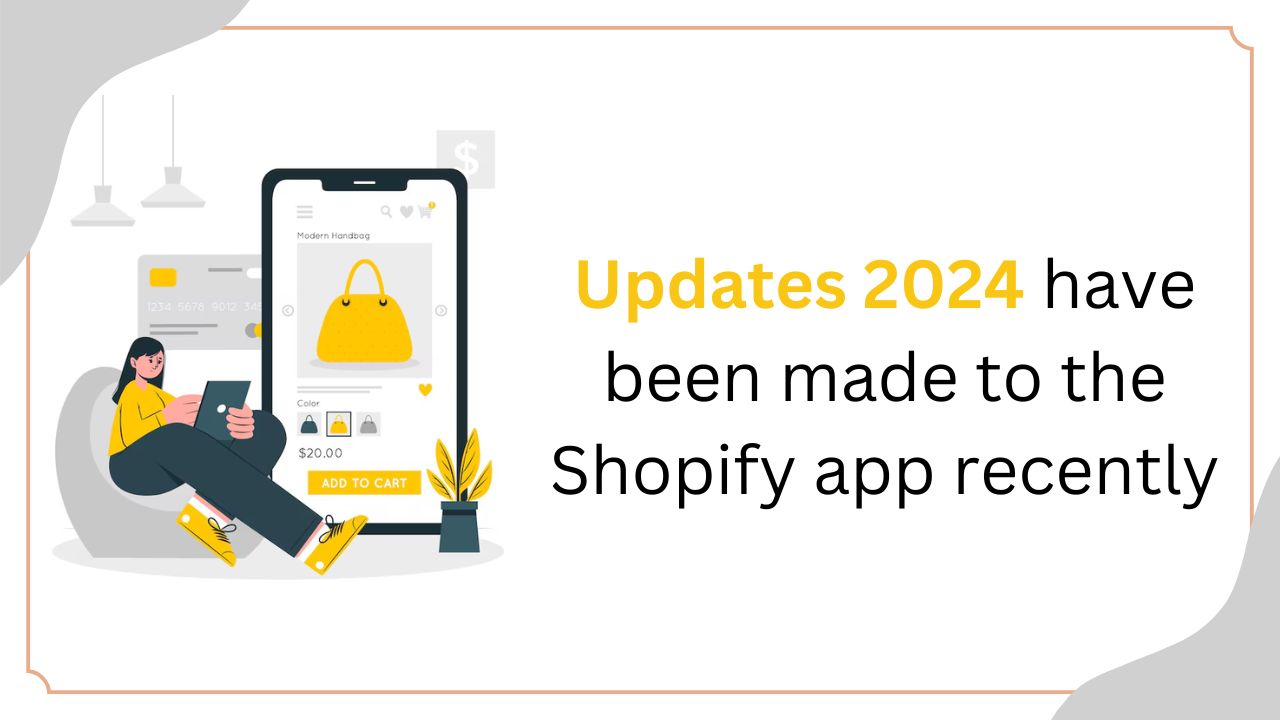What other updates have been made to the Shopify app recently?


I can't provide real-time updates on specific apps like Shopify since my training only includes information up to January 2022.
However, you can check the Shopify blog or their official changelog for the latest updates on their app. Usually, companies like Shopify release regular updates to improve functionality, fix bugs, and add new features to enhance user experience:
Collections details flow:
The collections details flow in the Shopify App has been updated to improve consistency between Products and Collections, allowing for better collections management.
The details of collections flow in Salesforce Flows involve the use of Variables, Collections, and Formulas to set and store values during a flow. These resources can be used together to control the logic of flows, allowing for conditional controls and the manipulation of data.
In the case of Salesforce, the size of a collection can be determined using an assignment formula, which can then be used in conditional controls and other elements of the flow.
The Collection Interface contains various methods that can be directly used by all the collections, including methods to add, remove, and check for the presence of elements, as well as methods to retrieve the size and iterate over the collection.
collections can be created and updated to store data that users can manage in the app. A collection is a group of similar items, such as products in a product list. Collections can be created and updated using the Collect function, and items can be removed using the Remove function.
Geolocation app sunset:
Shopify's Geolocation app will be sunset and uninstalled from shops that have it installed.
The Geolocation app sunset refers to the removal of the Geolocation app from Shopify's platform, which was announced in February 2024. The app will be uninstalled from shops that have it installed on December 1st, 2024. The reason for the removal is that Shopify's platform has made advancements that have reduced the need for the Geolocation app's consent-based localization feature for shops that use dedicated domains or shared domains.
These advancements include the expansion of the automatic redirection feature, automatic browser language redirection, and the consolidation of the GeoIP feature.
This will effectively bypass the Geolocation functionality on their storefront, and then they can safely remove the Geolocation app from their store. However, if they sell to customers in the European Union via an EU top-level domain.
Shopify Subscriptions app in full release:
The Shopify Subscriptions app is now available for all merchants, allowing them to increase customer lifetime value and recurring revenue.
The Shopify Subscriptions app is now in full release, allowing merchants to increase customer lifetime value and recurring revenue by offering subscriptions in their stores.
The app integrates seamlessly into the admin and makes it easy to set up and manage simple subscription use cases, giving customers the flexibility to pause or skip their subscriptions in new customer accounts.
The app supports both digital and physical products, with customizable pricing options including fixed pricing, subscribe and save, and custom pricing.
The app subscription model is based on time-based, usage-based, or a combination of time and usage-based subscriptions. The app can be used directly in Shopify admin and works with the latest themes.
The app has received mixed reviews, with some users praising its ease of use and others expressing frustration with its limitations and glitches, particularly for physical products.
New metaobjects experience in admin:
The admin experience for working with metaobjects has been simplified, featuring definition-specific views and improved search and filter capabilities.
Shopify Metaobjects is a new feature in the Shopify Admin that allows for the creation of custom content. Metaobjects are a group of meta fields that can be reused in multiple places across the site, with one central place to make updates.
They are reusable blocks of custom content that can be used to streamline store building. Metaobjects can be used to create custom data objects that can be used to customize store data and improve customer experiences.
They can be used to create customizable objects that can be used to consolidate diverse data elements into a single object for efficient organization. Metaobjects can be used for a variety of purposes, such as storing product information, managing size charts, displaying custom product information, and storing customer preferences.
They can be used in both the Shopify storefront and admin panel. Metaobjects can be controlled by access controls that can be configured to limit who can read or write to them. They can be set to be private, hidden away from the user's storefront, or accessible to all apps with the metaobject access scope.
Metaobjects can be used to create custom data models that can be used to feature complex content on multiple pages.
They can be added to Shopify pages through a five-part process that includes creating the meta-object, creating metaobject entries, creating a meta field definition that references the meta-object, connecting metaobject entries to specific products, and publishing the metaobject on the storefront. Metaobjects are a powerful tool for merchants looking to customize their store data and improve customer experiences.
New dynamic source selector in the online store editor:
This feature makes it easier to search and filter available meta fields and metaobjects in the online store editor.
A dynamic source in Shopify's online store editor refers to an attribute that updates to reflect its context. It can be an object attribute or a custom meta field attribute.
Dynamic sources allow users to display dynamic information on their online store by connecting meta fields or metaobjects to sections or blocks in the theme editor. For example, a merchant can use dynamic sources to display burn times for different types of candles by setting up product meta fields for burn time and connecting them to blocks in the product template.
This feature enables users to customize and personalize their online store content based on dynamic data sources, enhancing the flexibility and functionality of their storefronts.
New support for filter values that lead to no results:
Using the Search & Discovery app, you can now customize how your filter values are displayed when there are no matching products.
The search results do not provide direct information on the topic of new support for filter values which leads to no results. However, they do offer insights into filter behavior in different contexts, such as the "is not" filter in Service Now and filter verification in Google Analytics examples demonstrate how filters can affect the output of queries and data analysis.
While the search results do not directly address the topic of new support for filter values that lead to no results, they provide valuable context and insights into filter behavior in various systems.
If Analytics still cannot find any rows that would be affected by the proposed filter, it is possible that the current view does not collect the data being targeted by the filter. In ServiceNow, the "is not" filter specifically excludes records with empty values from the query output.
Smarter search that understands customer intent:
This feature allows customers to search for products using everyday language, available for Shopify Plus merchants in the Search & Discovery app.
Shopify's Smarter Search feature, Semantic Search, uses AI to understand customer intent beyond keyword matching, allowing customers to use everyday language in their searches. This feature helps drive sales and increase product discovery by returning richer and more relevant results.
The B-SMART Method, developed by TopSpot Internet Marketing, focuses on understanding buyer intent for industrial digital marketing.
This methodology, which has been in use for almost 20 years, helps identify the audience most likely to search for specific products or services, attracting traffic more likely to drive new business opportunities. The B-SMART Method has evolved and is still relevant in the age of artificial intelligence, where it can inform the generation of answers that match user intent.
By recognizing customer intent, businesses can create more targeted marketing campaigns, increase engagement and loyalty, and improve operational efficiency, leading to higher customer retention and business success.
Intent Detection, a critical feature for analyzing customer queries, can adapt to the diverse range and complexity of these queries, leading to empathetic understanding and mimicking the nuanced communication of human interaction.
Understanding customer intent is crucial for businesses to make smarter decisions, improve customer satisfaction, and drive new business opportunities. Various techniques and methods, such as AI-powered search features, the B-SMART Method, intent analysis, and generative AI, can help businesses understand customer intent and improve their marketing strategies.
Customer Privacy settings in Shopify admin:
Merchants can now manage privacy settings centrally with the new Customer Privacy section in Shopify Admin.
The Customer Privacy settings in Shopify admin are crucial for managing privacy settings, complying with privacy laws, and ensuring transparency with customers. These settings allow merchants to customize privacy settings on a per-region basis, set up privacy policies, add cookie banners, enable data opt-outs, and view data storage information.
Additionally, the introduction of the Customer Privacy section in Shopify Admin integrates features from the Shopify Privacy & Compliance app, providing an all-in-one solution for managing privacy settings and expanding into new markets.
This update streamlines the process of configuring privacy settings per region, setting up privacy policies, adding cookie banners, enabling data opt-outs, and viewing data storage information, making it easier for all Shopify users to comply with privacy regulations and enhance customer privacy.
The Customer Privacy settings in Shopify admin play a vital role in helping merchants prioritize customer privacy, comply with privacy laws, and maintain transparency with their customers.
These settings enable customization on a per-region basis, facilitate the setup of privacy policies and cookie banners, and provide essential tools for managing data opt-outs and data storage information, ultimately contributing to a trustworthy and compliant ecommerce environment.
Provisioning POS access from Plus admin:
The search results do not provide direct information on the topic of provisioning POS access from Plus admin. However, they do offer insights into provisioning apps under Kiosk mode in Android devices.
This feature allows admins to lock down devices to a single app and pre-configure settings over the air, which is useful for POS devices that are usually at critical points in an organization. Additionally, the Kiosk mode allows for the provisioning of multiple apps under the Kiosk, ensuring that settings cannot be modified by users.
In the context of Shopify, the search results highlight various updates and features related to the platform, such as reduced permissions for POS login, the introduction of new search capabilities within the Shopify Translate & Adapt app, and the ability to cancel orders and void transactions on POS.
The search results do not provide direct information on provisioning POS access from Plus admin. However, they do offer insights into provisioning apps under Kiosk mode in Android devices, which can be useful for managing POS devices in an organization.
Refund to an existing gift card:
The search results provide information on refunding to an existing gift card in Shopify. Shopify now allows staff to refund the product or order value to an existing physical or digital gift card during the return process.
This feature is particularly useful for customers who have lost their original gift card or have already spent part of the balance. However, the search results also highlight the limitations of refunding a gift card when the original payment was split between a gift card and another form of payment.
This issue has been a struggle for many businesses, as it creates confusion for cashiers, an annoyance to customers, and complicates bookkeeping. Despite the feedback from the community, Square has not yet provided a solution for this issue.
Shopify allows refunds to an existing gift card, while Square has not yet addressed the issue of refunding to a gift card when the original payment was split between a gift card and another form of payment.
Streamlined attribution workflows in POS:
Attribution workflows have been streamlined, allowing for easier attribution of carts and items to staff members.
The search results do not provide direct information on the topic of streamlined attribution workflows in POS. However, they do offer insights into various aspects of POS, such as POS PIN enhancements, the ability to send cart POS attribution, and changes to how payouts are presented on Shopify Markets Pro orders.
Additionally, the results highlight the importance of user provisioning and governance tools in managing user access to POS and e-commerce systems.
While the search results do not directly address the topic of streamlined attribution workflows in POS, they do provide relevant information on POS-related features and tools that can contribute to more efficient and secure POS operations.
Product details page improvements:
Several improvements have been made to the Product details page to make gathering information faster and easily discoverable by merchants.
The search results provide insights into various aspects of product page improvements, including design, content, and functionality. Here are some key takeaways:
Product Details Page Improvements: Shopify has introduced organizational updates to the Product page, giving associates quick access to precise information like identifiers, inventory, and specifications
This helps associates answer customer questions and helps customers make informed buying decisions.
Split View for Tablets: The new split screen view for tablets allows staff to view multiple product identifiers and inventory details within a single view, improving the amount of information scannable within a single view.
New Image Viewing Gestures: The new touch-based viewing gestures scale product images to make it easier for customers to view product details.
Consolidated Product Specifications: Vendor and Organization are now consolidated into a single row and expand out to drill deeper into details, making it easier for customers to view product specifications
Rich Text Product Descriptions: Product descriptions now expand into a full view that supports plain text for basic details or rich text formatting for advanced elements like headers, lists, images, or tables.
product page improvements involve optimizing the design, content, and functionality of product pages to make it easier for customers to make informed buying decisions. This includes organizational updates, split views for tablets, new image viewing gestures, consolidated product specifications, rich text product descriptions, and best practices for product page optimization.
NEED HELP WITH YOUR STORE?
Webunity are officially recognised Shopify experts. Our Shopify developers are some of the highest rated in the world. See our Shopify Expert service list below:
SHOPIFY SERVICES
Need a help?
Our Shopify Plus Consulting services offer you a wide range of solutions for designing and developing online stores with SEO-relevant services
SUBSCRIBE






